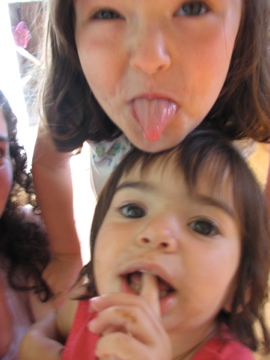You’re clear that you want to be a kind, caring, and compassionate parent. You don’t want to yell or spank your kids, but sometimes it’s hard to know if gentle discipline is actually working.
There are time when your kid is completely out of control and it’s confusing to figure out what to do about it when threatening, coercing, bribing, and punishing are all off the table. But there are things you can do that will dramatically increase cooperation without the destructive effects of coercion and punishment.
1) Keep Your Cool—
This is crucially important but MUCH easier said than done. Essentially, we’re teaching our kids emotion regulation by providing a healthy example for them. So the more we can breathe, relax, and express boundaries dispassionately, the better things will go.
If you find yourself loosing it, try disengaging from your child and take a moment to cool off in another room. It may also be helpful to name your emotions, “I’m feeling really frustrated so I’m going to go into my room for a few minutes and we’ll talk more when I’m more relaxed.”
If emotions are heated, save the conversation about why your child should follow the rules for another time. When kids are emotionally activated, they’re unable to learn anything new and you’ll just get more and more upset thinking that they’re not listening, when in reality, they’re unable to process any information because they’re so emotionally triggered.
2) Compassion for Kids—
Recognizing that children act out because they’re hurt, confused, or struggling in some way can be a huge eye opener. Children do not want to push our buttons, no matter how much it seems like they do. Rather, they’re trying to get their needs met and they’re learning how to advocate for themselves, sometimes in ways that make us want to scream.
The truth is that a misbehaving child is asking for empathy, and understanding. They just haven’t learned very effective ways to win our support yet. So instead, they whine, hit, scream, spit, and try all sorts of ineffective strategies. Seeing these behaviors as a cry for help and an experiment can make it much easier to treat our kids with compassion when their behavior is out of control.
3) Play—
When kids are defiant, as strange as it seems to us, they’re often expressing a need for play. By being playful with your contrary child, you can turn defiance into cooperation. But beware, what works one time is not guaranteed to work the next time. So you’ll need a whole bunch of potential games to play at any given moment. If being playful isn’t your usual MO, I’d recommend sitting down and coming up with a list of games and ways to play when you’re faced with a child who doesn’t want to cooperate. Refer to your list when you find yourself wanting to control and force your child to cooperate.
Here’s my own list of games to get you started:
- Play the “you better not do that!” game
- Pretend she doesn’t know how to do it and ask her to prove it
- Ask her to teach her doll how to do it
- Talk in a funny voice
- Sing a silly song about it
- Pretend she’s a baby and do it for her
- Pretend we’re animals and hop, roar, or slither our way through
- Put her in charge
- Let her know that I’ll be very surprised if I notice it’s already done
- Make it a race and time how long it takes
4) Setting Clear Boundaries—
Children desperately need boundaries, but they also need a limited number of rules to follow and some amount of flexibility depending on the situation. That can make setting clear and consistent boundaries seem like some sort of unattainable nirvana of gentle discipline. Especially when it seems like they only listen to us when we lose it and yell at them. So here are my strategies for how to set consistent boundaries in a gentle way:
a) Make a short list of essential rules. These are things that are safety issues, or things that drive you batty and you will not abide. Make sure your list has no more than 5 items of these “non-negotiable” rules.
b) During a time when everyone is calm, ask your child to agree to the rules and have a discussion about why these rules are so important to you. Ask your child what she thinks of the rules and if there are any she’d like to remove or add. Really have a discussion with your child about this and be sure to let her know that while you’ll take her ideas into consideration, and you hope you can all agree, ultimately you’re the parent(s) so you’ll make the final decision on the rules for your family.
c) Do your best to make it almost impossible for your child to break the rules. For instance if your rule is “we always hold hands in the parking lot” make sure YOU take your child’s hand or wrist every time. If the rule is “no hitting the baby” provide additional supervision, space between siblings, and begin to remove the baby from the room if you notice your older child getting agitated.
d) Come up with a protocol for what you’ll do if the rule is broken. I don’t advocate any form of punishment, however, you do need to know exactly what you’ll do if the rule is broken to encourage adherence to the rule in the future and to acknowledge that the rule has been broken. Having this protocol in place can also help you keep your cool and remember that your child is simply testing the boundaries, which is a huge part of learning and understanding rules.
In the above examples you might choose to go back home because parking lots aren’t safe or you may separate the kids if hitting occurs. There are times when I have removed toys or other objects, especially when they’re dangerous and I occasionally limit my daughter’s mobility (i.e. sit by her bedroom door so that she cannot leave at bedtime) It’s up to you to decide what you’ll do based on your 5 most important rules.
e) Be more flexible with limits you’d like to set but which aren’t as essential to safety or sanity. The more freedom and autonomy your child experiences outside of the main rules, the more likely his needs for freedom will be met and he’ll choose to adhere to the major rules.
f) Address the underlying needs. Whenever kids act out it’s because they need something. When we can identify the need and address it directly, we reduce the incidents of pushing the limits and we nurture and care for our child in a way that really nurtures and supports them. For instance, often the need underneath hitting is either for space and/or touch. By checking in and either offering some alone time or snuggles, we eliminate the reason our child broke the rule in the first place.
Alright, so there you have it! I would love to know if these strategies work for you too, so please share your story or idea below.
And have a fabulous week, Shelly



Have you tried the “practice a tantrum” technique? I saw it suggested on Dr. Phil and it peaked my interest. My 4yo has horrible tantrums. Like, screaming bloody murder, spitting, hitting, etc… We’ve tried everything we can think of and nothing makes it stop. It wouldn’t be so bad if they only happened at home (we can put him in a room alone to calm down without stimuli) but they occasionally happen in public…he screams like we’re hurting him and I live in fear that CPS is going to knock on my door.